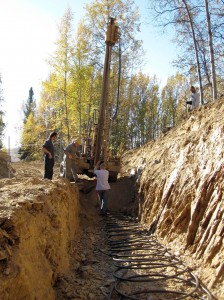Report shows heat pumps economically viable in Alaska
June 23, 2011
907-590-0879
6/23/11
Ground source heat pumps offer an economically viable heating option in some places in Alaska, according to a new report from UAF’s Alaska Center for Energy and Power and the Cold Climate Housing Research Center.
The study found that the systems, which extract heat from the earth, are technically and economically viable in areas with high heating costs and low electric costs. The report, funded by the Denali Commission, offers the first in-depth assessment of ground source heat pumps in Alaska.

“There recently has been quite a bit of excitement about ground source heat pumps, as people are seeking more affordable heating options. Our report helps explain the technology in the context of Alaska, and analyzes its potential throughout the state,” said co-author Colin Craven, head of product testing at CCHRC.
There are roughly 50 heat pumps in Alaska, including high-profile commercial installations at Weller Elementary School in Fairbanks and the Juneau Airport Terminal as well as several residential installations around the state. A heat pump transfers energy from the earth or water to use for heating or cooling. The system consists of underground tubing filled with heat-transfer fluid, an electric pump and a heat distribution system.
Researchers reviewed the industry in Alaska, interviewed ground source heat pump owners and assessed the performance and economic viability of the technology in five cities: Fairbanks, Anchorage, Juneau, Bethel and Seward. They compared the cost and performance of heat pumps with traditional heating systems in an average-sized new construction home in each city. They found that heat pumps could match or beat other heating systems in Fairbanks, Juneau and Seward.
“Even though the ground source heat pumps have high up-front capital costs, which is what deters people from installing them, they end up costing less over 15 years just because you save so much money on annual energy costs,” said Dominique Pride, graduate researcher at ACEP and co-author of the report.
The systems are most economical in Juneau and Seward, where heating oil is expensive and electricity costs are low. They also potentially make sense in Fairbanks, which has more expensive electricity than Southeast and Southcentral but also higher heating demand and costs, thus more room for energy savings.
The analysis found the pumps are not economical in Anchorage, which has low heating and power costs thanks to inexpensive natural gas. And they are not viable in Bethel and most of rural Alaska because of its extremely high electricity costs.
In addition to economics, researchers looked at cold climate considerations on system performance, including the impact of ground source heat pumps on soil, as extracting heat could create more permafrost if the ground temperature doesn’t recover in the summer. Researches plan to install a pump at the CCHRC next year to further study the effects and viability of the systems.
ADDITIONAL CONTACTS: Molly Rettig, CCHRC communications coordinator, 907-450-1772, molly@cchrc.org. Marmian Grimes, UAF public information officer, at 907-474-7902 or via e-mail at marmian.grimes@alaska.edu.
NOTE TO EDITORS: A photo of the installation of a ground source heat pump is available online at www.uafnews.com.
JE/6-23-11/259-11


